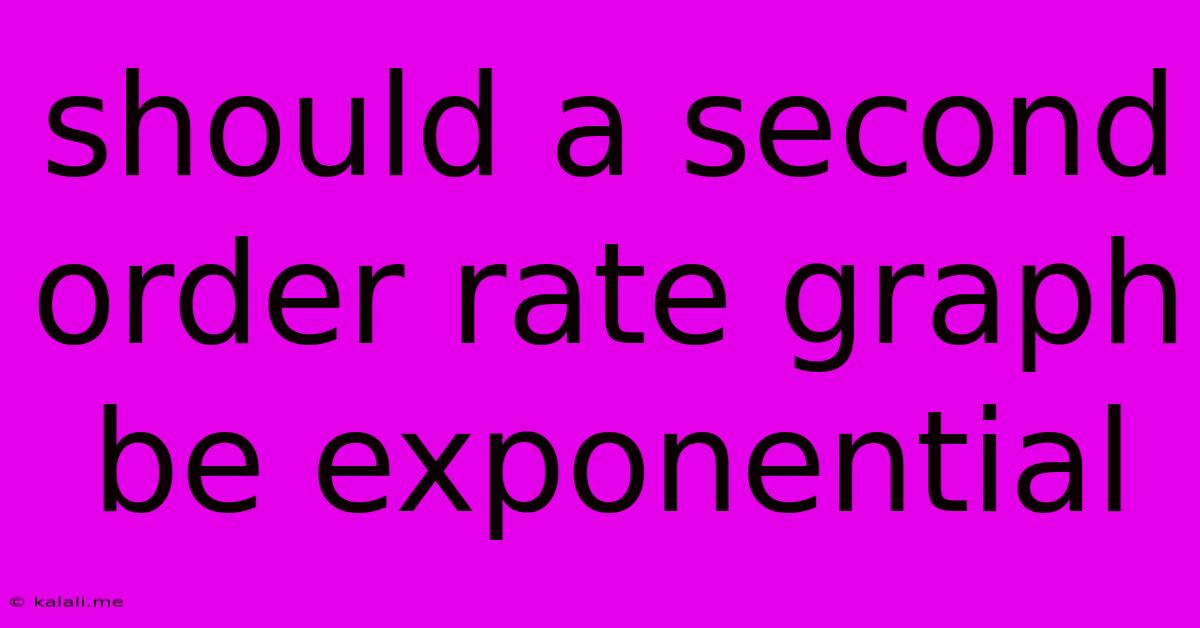Should A Second Order Rate Graph Be Exponential
Kalali
Jun 01, 2025 · 3 min read

Table of Contents
Should a Second-Order Rate Graph Be Exponential? Understanding Reaction Kinetics
The question of whether a second-order rate graph should be exponential often leads to confusion. The short answer is: no, a second-order rate graph is not exponential, but it's often mistaken for one. This article will clarify the difference, explaining the graphical representation of second-order reactions and why they appear seemingly exponential at times. Understanding this distinction is crucial for accurately interpreting kinetic data and applying the correct rate laws.
The integrated rate laws provide the mathematical relationships between concentration and time for different reaction orders. These equations are essential for plotting concentration vs. time graphs and determining the reaction order from experimental data.
Understanding First-Order Kinetics
Before diving into second-order reactions, it's helpful to revisit first-order kinetics. A first-order reaction has a rate that is directly proportional to the concentration of one reactant. Its integrated rate law is:
ln[A] = -kt + ln[A]₀
where:
- [A] is the concentration of reactant A at time t
- k is the rate constant
- [A]₀ is the initial concentration of A
Plotting ln[A] against time yields a straight line with a slope of -k. This is the key characteristic of a first-order reaction: a linear relationship when plotting the natural logarithm of concentration versus time. This is often confused with an exponential decay curve, which is also commonly visualized, especially when only examining the raw concentration vs time graph.
Second-Order Kinetics: The Integrated Rate Law
A second-order reaction has a rate proportional to the square of the concentration of one reactant (or the product of the concentrations of two reactants). The integrated rate law for a second-order reaction with one reactant is:
1/[A] = kt + 1/[A]₀
This equation shows that a plot of 1/[A] versus time will produce a straight line with a slope of k. This is the definitive characteristic of a second-order reaction.
Why the Confusion?
The confusion arises from visualizing the raw concentration-time data. A second-order reaction shows a decrease in concentration over time, similar to exponential decay. However, the relationship isn't truly exponential. The crucial difference lies in the type of function relating concentration and time.
- Exponential Decay: Characterized by a constant fractional decrease in concentration per unit time.
- Second-Order Kinetics: Characterized by a constant reciprocal change in concentration per unit time.
The exponential curve is described by an equation with a negative exponent whereas the second-order integrated rate law involves a simple reciprocal relationship without exponentials. While the raw concentration-time plot may visually resemble an exponential decay, only a plot of 1/[A] versus time will yield a straight line for a true second-order reaction.
Identifying the Order from Experimental Data
To determine the order of a reaction experimentally:
- Plot different graphical representations: Plot [A] vs. time, ln[A] vs. time, and 1/[A] vs. time.
- Identify linearity: Whichever plot yields a straight line indicates the order of the reaction. A straight line for 1/[A] vs. time signifies a second-order reaction.
- Calculate the rate constant: The slope of the linear plot gives the rate constant (k).
In conclusion, although the concentration-time curve of a second-order reaction might seem exponential at first glance, it is fundamentally different. The integrated rate law and the resulting linear relationship between 1/[A] and time are the definitive proof of a second-order reaction. Always perform the necessary graphical analysis to correctly identify the reaction order. Accurate determination of reaction order is essential for understanding reaction mechanisms and predicting reaction behavior.
Latest Posts
Latest Posts
-
How Many Amps Can 10 Gauge Wire Handle
Jun 03, 2025
-
Integral Of The Absolute Value Of X
Jun 03, 2025
-
How To Start A Car With A Dead Key Fob
Jun 03, 2025
-
Final Fantasy X Al Bhed Primers
Jun 03, 2025
-
Realeases Oh Ions Acids Or Bases
Jun 03, 2025
Related Post
Thank you for visiting our website which covers about Should A Second Order Rate Graph Be Exponential . We hope the information provided has been useful to you. Feel free to contact us if you have any questions or need further assistance. See you next time and don't miss to bookmark.